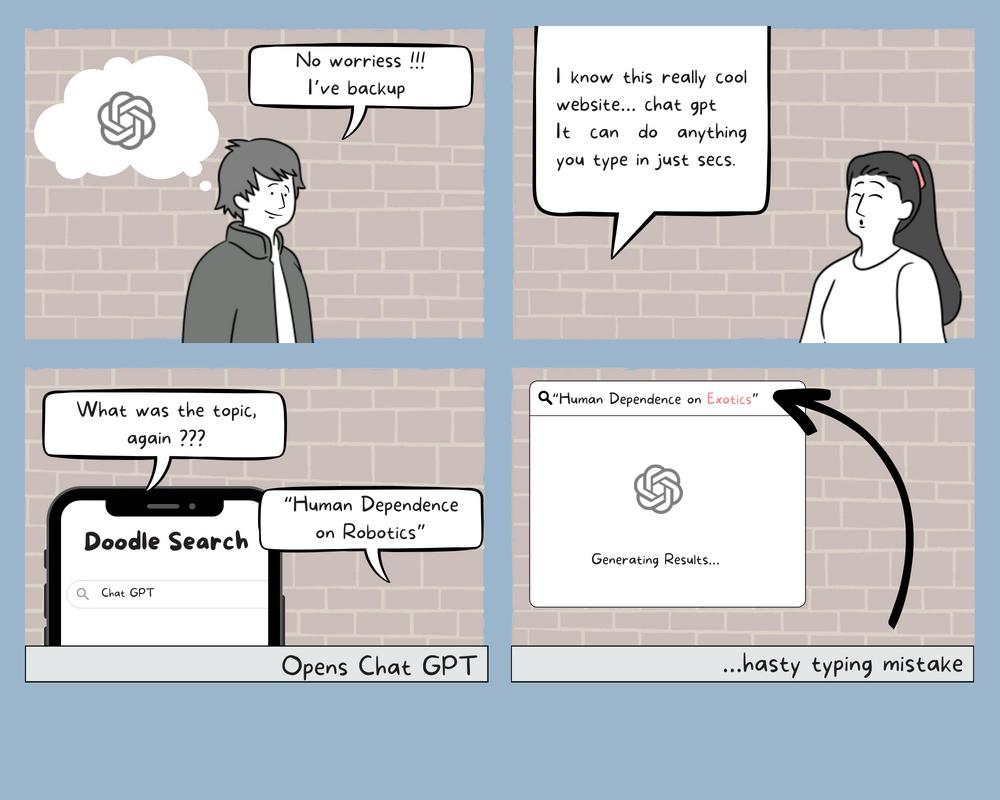
6 minute read
ARTIFICIAL INTELLIGENCE IN CREATING POSITIVE CLIMATIC CHANGE
By:- Eivranpreet
Inflation is a worldwide problem, and it's one that is being severely impacted by climate change. This is because the increased frequency and severity of extreme weather events drive up prices for food, energy, and other necessities. But there is hope: AI can help us fight climate change by reducing emissions, improving energy efficiency, and increasing the use of renewable energy sources. Therefore, the Green transition is a key pillar in fighting inflation, and AI is an important tool in this effort
Advertisement
Therefore, a new framework for climate AI is vital to focus the debate on investments and innovation in space. "To effectively address the underlying drivers and risks of our excessive reliance on fossil fuels, we need to embrace a mosaic of innovative solutions AI sits at the center of that mosaic and is already contributing to massively increased transparency, faster gains in efficient power generation and storage, and a renewed confidence in large-scale investments,” states James Hodson, CEO of AI for Good Foundation.
Mitigation and fundamentals are critical to our efforts to combat climate change, but adaptability and resilience are necessary for ensuring that people and the economy can withstand the effects of climate change today True resiliency will require us to take a systems-level view of the world and use AI to help us identify risks, vulnerabilities and potential disruptions when it comes to climate change. We must also build the capacity and capabilities to respond rapidly to these threats and create resilient architecture

Macro-level measurement: Overall environmental emissions are a crucial component of models that project future climates. AI may aid such models by improving measures, for example, or scanning remote-sensing data from satellites for further analysis.
Micro-level measurement: Producers can use micro-level emissions measurements to understand the carbon footprints of their products, track their progress towards ESG targets, or identify opportunities to reduce scope 1, 2, and 3 emissions. Consumers can use this information to make more informed choices about the products they purchase and their actions to reduce their carbon footprints.
Reduction

The global climatic emergency necessitates accelerating efforts to reduce current emissions and their resulting Green House Gas consequences. Immediate and ambitious mitigation measures are essential for averting the most catastrophic consequences of climate change. There are three components to reduction: Reduction of GHG emissions intensity: AI solutions can be used to support the switch toward new energy sources. Supply forecasting for solar energy can help us identify areas where there is potential for increasing the use of solar energy, thus reducing GHG emissions.
Reducing Emissions-Generating Activities: AI can also reduce emissions by optimizing supply chains through improved demand prediction (to combat overproduction) or efficient transportation of goods (such as shortening delivery times and minimizing energy use). This can be done using data to generate models that predict demand or optimize transportation routes.
Reduction of greenhouse effects: If policymakers turn towards geoengineering solutions to curtail the effects of climate change, AI will be an essential tool for accelerating chemistry research and can help us to develop new materials and processes that result in less greenhouse gas emissions. Additionally, encouraging behavioral change can reduce energy consumption and lower emissions.
Removal
Removing greenhouse gasses from the atmosphere is one way to mitigate climate change. This can be done by natural processes, such as increased photosynthesis by trees, or by technological means, such as carbon capture and storage. There are two main types of removal:
Environmental removal: Natural ecosystems such as forests, algae, and wetlands play a central role in atmospheric carbon removal. Monitoring these ecosystems requires gathering and processing large amounts of data, a situation in which AI is very effective.
Technological removal: Environmental removal can be complemented with industrial processes, but those processes are still at their inception, facing scaling issues. AI would be a strong ally in solving these issues as quickly as possible. Having solidified the Mitigation portion of the framework, we now need to focus on the Adaptation side.
Cryopreservation, as we know, basically means the maintenance and preservation of vitality of biological constructs, be it organs, cells or structures,byloweringthetemperatures to extremely low levels. We, as medical students, are oftentimes exposed to the concept of cryopreservation. It could be preserving the cornea, or blood samples;organsfordonationandmore!

In principle though, cryopreservation is not simply freezing the tissues The reason for this is that simple cooling or freezing for a long time will result in ice crystal formation, osmotic shock, and membranedamageduringfreezingand thawing causes cell death. The freezing behaviour of the cells can be altered in the presence of a cryoprotective agent (CPA; also called cryoprotectant), which affects the rates of water transport, nucleation,andicecrystalgrowth.
Since ancient times, it has been known that biological material can be preserved longer at low temperatures. The ability to reliably generate the extremelylowtemperaturesrequiredfor long-term preservation, typically below 100 °C, came with the development of cryogenictechnologiesattheturnofthe twentieth century. The modern cryopreservationoflivingsystems,inthe sense of biotechnology, can be traced to the discovery of the first effective cryoprotective agents (CPAs), otherwise knownas“cryoprotectants”,inthe1940s. CPAs act to reduce the aforementioned damage via a number of actions, many of which have not yet been fully identified. Some main effects are those of reducing the concentration of electrolytes and also reducing ice formation by hydrogen bonding with water molecules to prevent them from bondingtoicecrystals
Current applications of Cryopreservation include Organ preservation and banking, tissue and cell banking, fertility solutions, stem cell preservation, and more Cryopreservation has been integral in increasing the life of organs meant for transplantation, and has saved countless lives. Adjunct innovations to cryopreservation have also improved the capability of medical science to prolong the life of organs. This is especially useful in transporting organs, improving their vitality so that the amount of waste of organs and tissues meant for donation is reduced as much aspossible.
Besides the medical applications described above that are already being explored, improved capabilities for artificially lowering the temperature of biologicaltissuecouldhaveasignificant impact in many other fields. For instance, the possibility to gain more time is crucial in emergency medicine. Indeed,moderatestatesofhypothermia are common in clinical practice Along those lines, therapeutic hypothermia has been associated with beneficial outcomes in patients following out-ofhospital cardiac arrest. While lowering temperaturesisatechniquecurrentlyin practise, more research is required to institutionalise this technique in common day to day practise. In a more out-of-this-world approach, cryopreservation techniques can also havemajorimpactonspacetravel!
Cryopreservation is an interdisciplinary endeavour between medicine, biology, bioinformatics, chemistry and physics. The main challenges still to overcome are scaling up current methods to larger volumes and complex tissues. The larger the organ, or tissue volumes to be vitrified, correspondingly more timeisrequiredtocoolandwarmthe organ. The challenges in cryobiology are not insurmountable Future research will focus on ever more complex ways to prevent ice formation and mitigate cryoprotectant toxicity; novel cryoprotectants which exert disproportionately large cryoprotective effects compared to theirconcentration,insilicomolecular modelling, and enhanced understanding of the processes that occur during cryopreservation will all be employed. In a nutshell, cryopreservation is an exciting, new realm which can have many more impactsonmedicalpractise,andcan improve critical care Put in an amorous way, freezing death can extendlife.

Clinicaldecision-makingsupport,riskstratification, genomics, imaging and diagnosis, precision medicine, and drug discovery are all areas where AI is playing an increasingly essential role as a result of recent advances in medicine. Early techniques in artificial intelligence in surgery concentrated on feature identification and computer-assisted intervention for both preoperative planning and intra-operative guidance, with their roots firmly planted in imaging and navigation. Simply said, AI is gradually altering surgical procedures because of developments in imaging,navigation,androboticintervention.
Overthecourseofthelastdecade,therehasbeena significantriseinthenumberofsurgicalprocedures that make use of robotic equipment. The use of robotic surgery has become increasingly commonplaceinavarietyofsurgicalspecialties, including general surgery, urology, and gynaecology. Recent research has started looking into the possibility of employing robotic technology in the field of spine surgery Fixationofthespinethroughtheplacementofpediclescrewsisacommon requirement for surgical operations involving the spine. This is a task that could potentially benefit from the utilisation of robotic technology. When it comes to the placement of pedicle screws, there is minimal room for error because improper placement of the screws might result in major consequences such as harm to the nervoussystemorthebloodvessels Roboticspinesurgeryisbecomingincreasingly popular, and technological improvements in this area mirror an increasing drive to improve patient safety and outcomes. Interest in minimally invasive spine surgery hasalsocontributedtoroboticadvancementsinceroboticguidingsystemsarewell suitedtothistypeofsurgery.


Themanagementofspinaldiseasesfrequentlynecessitatestheinsertionofpedicle screws.Techniquesforpediclescrewpositioningwereinitiallypublishedinthelate 1950s, and they have undergone numerous adaptations and methodological breakthroughs since then. The description of open and percutaneous approaches employing a variety of guided techniques is among these advancements.Pedicle screw implantation has emerged as a key prospect for robotics in spine surgery. Pediclescrewmisalignmentcanresultinsignificantneurovascularproblems,which can contribute to poor results and necessitate reoperation. Accurate screw placement is thus critical for avoiding iatrogenic problems and improving surgical results.
Thepreciseoperatingtechniqueandsurgicalworkflowwilldifferdependingonthe robotic system used. The widespread use of robotic devices for pedicle screw placement must be accompanied by safe and dependable precision. The Gertzbein-Robbins classification system is the most widely utilised in the literature. The accuracy of pedicle screw placement utilising robotic devices has been reported to be typically high, with rates as high as 94%- 98%. The literature on the accuracyofroboticallyimplantedpediclescrewsversustraditionalopenfreehand procedures is equivocal. Some studies have found that robotically aided pedicle screwplacementislessaccurate.Inonerandomisedcontrolledtrial,93%ofpedicle screwsinsertedfreehandwereGertzbein-RobbinsAorB,comparedto85%ofthose placedwiththeROSASpineAssistrobot.
Robotic systems are now widely used across the United States and in a variety of surgical subspecialties. However, it is still not widely used in developing nations such as India. This cutting-edge technology is permeating the field of spine surgery. These technologies have the potential to improve screw insertion accuracy, reduce operative time, and reduce radiation exposure. However, there is a steep learning curve,andmanytechnologicalaspectsofthese systems are always being reviewed in order to increase operational efficiency and satisfy theseobjectives.Maintainingclinicalparitywith established screw placement procedures, such as freehand screw placement and other forms of navigation, will be critical for broader adoptionofthesedevicesinourarea.

article by-










